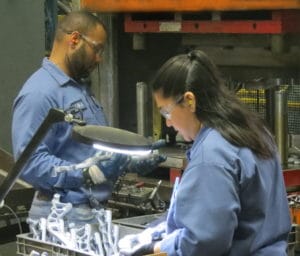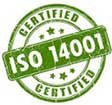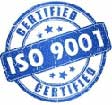Economy and efficiency are just two reasons to use the die casting process.
 If you’re looking for the most economical, efficient technology to produce your component in a durable and rigid metal form, the high-pressure die casting process is the solution. It provides the broadest range of shapes compared to other manufacturing techniques. Also, the high pressure die casting process provides a high degree of dimensional accuracy and offers:
If you’re looking for the most economical, efficient technology to produce your component in a durable and rigid metal form, the high-pressure die casting process is the solution. It provides the broadest range of shapes compared to other manufacturing techniques. Also, the high pressure die casting process provides a high degree of dimensional accuracy and offers:
- The ability to produce complex shapes with tight tolerances
- Thin wall metal castings
- High production rates
- Long service life
- Lowest per-part-piece price
Benefits of Die Casting
Die casting is an efficient, economical process capable of producing a broader range of shapes and components than other metal casting or forming techniques. Die cast parts typically have a long service life and generally are designed to complement the surrounding part’s visual appeal. Designers can gain several advantages by using die cast parts, such as:
- High-speed production: Die castings can be produced into complex shapes with closer tolerances than most mass production processes. Most of the time, little to no machining is needed, meaning thousands of identical parts can be produced before additional tooling is required.
- Dimensional accuracy and stability: Die casting produces durable and dimensionally stable parts while maintaining close tolerances.
- EMI and RFI shielding: Die cast parts are also heat and UV resistant and provide EMI and RFI shielding.
- Strength and weight: In most cases, die cast parts are stronger than plastic injection moldings and are generally stronger and lighter than parts created from other casting methods.
Die Casting Process Overview
The die casting process consists of many steps, but it can be broken down quite simply. There are two types of die casting methods, hot chamber and cold chamber die casting. Hot chamber die casting is used for parts made from zinc or magnesium. During this process, the alloys are melted at the die casting machine itself, and the molten metal enters the “gooseneck” automatically. The hydraulic-powered vertical piston then forces the metal through the gooseneck and into the die.
Cold chamber die casting is used to cast aluminum parts. During this process, large quantities of aluminum are melted in a separate furnace and then transferred to the die casting machine, where it is held in the “holding furnace.” When the cycle starts, a specific amount of molten metal is “ladled” into an unheated injection cylinder, and a horizontally mounted hydraulic piston pushes it into the die.
The total cycle time to go from liquid metal to a solid die cast part can vary from project-to-project – some cycles can last one second or less, some can last for two-to-three minutes. Following the solidification of the metal inside the die cavity, the machine’s hydraulic clamping system releases the moving die half, allowing the ejection system to push the casting out of the mold. Castings are then transferred to the next stage in the process (such as die trim) to remove excess material – like gates, runners, overflows, and flash – from the part.
The CWM Difference
Chicago White Metal offers design help from a staff of exceedingly qualified engineers. CWM also offers extensive in-house CNC facilities, and we work with highly trained toolmakers to help ensure a quality product. This hands-on approach even goes as far as to help develop different finishes for your product by working with outside finishing companies to help get you the most cost-effective, socially responsible solution.
Request a quote today on a custom die casting solution for your application, or contact Chicago White Metal for more information.





